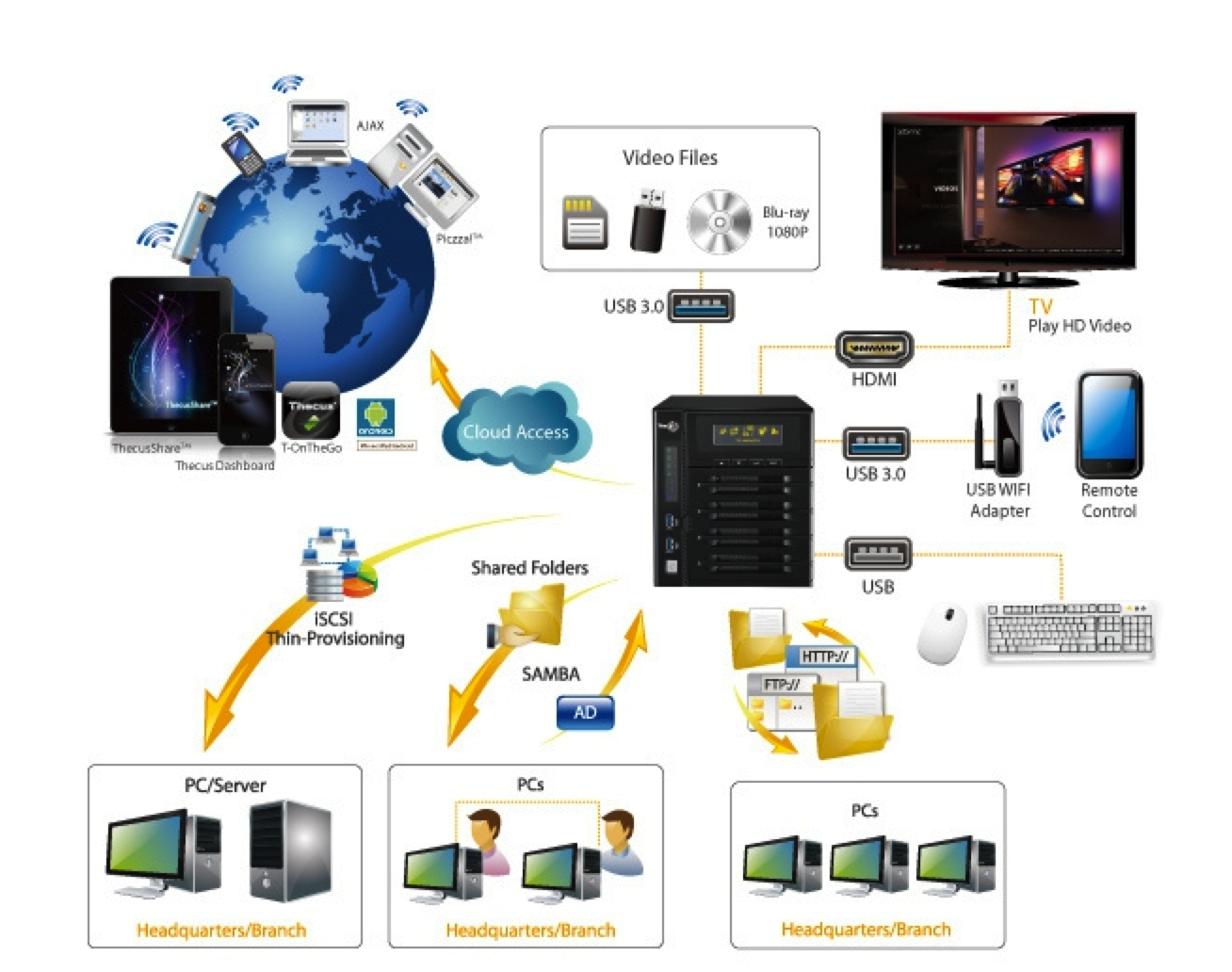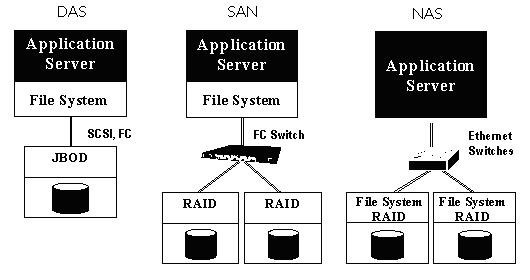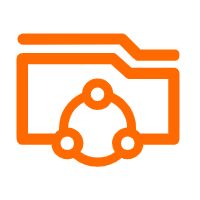NAS is defined as a special dedicated data storage server that includes storage devices (such as disk arrays, CD/DVD drives, tape drives, or removable storage media) and embedded system software that provides cross-platform file sharing capabilities. NAS usually has its own node on a LAN without the intervention of the application server, allowing users to access data on the network. In this configuration, the NAS centrally manages and processes all data on the network, offloading the load from the application or enterprise server. It can effectively reduce the total cost of ownership and protect user investment.
NAS itself can support a variety of protocols (such as NFS, CIFS, FTP, HTTP, etc.), and can support various operating systems. Through any workstation, the NAS device can be managed intuitively and conveniently by using IE or Netscape browser.
NAS connects storage devices to existing networks to provide data and file services. A NAS server generally consists of several parts, such as storage hardware, operating system and file system on it. NAS directly connects the disk storage array through the network, and the magnetic array has the characteristics of high capacity, high performance, and high reliability. NAS connects storage devices through a standard network topology and can directly access the Internet without a server. It does not rely on a general operating system but adopts a user-oriented simplified operating system specially designed for data storage. protocol, which makes the management and setup of the entire system simpler.

NAS solutions are usually configured as file serving devices, with file access by workstations or servers via network protocols (such as TCP/IP) and applications (such as Network File System NFS or Common Internet File System CIFS). Most NAS connections are made between workstation clients and NAS file sharing devices. These connections depend on the enterprise's network infrastructure to function properly.
In order to improve system performance and uninterrupted user access, NAS uses specialized operating systems for network file access. These operating systems support both standard file access and corresponding network protocols, so NAS technology can meet specific requirements. User needs. For example, when some enterprises need to cope with the problem of rapid data growth, or to solve the system limitations caused by independent work environments, a new generation of NAS technology can be adopted to solve these problems by using centralized network file access mechanism and sharing , so as to reduce system management costs and improve data backup and recovery functions.
There are two ways to implement NAS: unified NAS and gateway NAS.
An integrated NAS device includes all the parts of NAS, such as NAS engine and storage, in one frame, which makes NAS have an independent environment. The NAS engine provides external connections through the IP network to respond to file I/O requests from clients and services. Storage consists of multiple hard drives, which can be low-cost ATA interfaces to high-throughput FC hard drives. The management software manages the NAS engine and storage configuration. A unified NAS solution ranges from a low-end device in a single frame to a high-end solution connected to an external disk array.
A gateway NAS consists of a standalone NAS engine and one or more storage arrays. The NAS engine here has the same function as the NAS engine in the unified NAS solution, and uses block-level I/O when the storage is shared by other applications. Management functions are more complex in a gateway type solution than in an integrated environment because the NAS engine and storage need to be managed separately. In gateway NAS solutions, FC architectures such as switches, directors, or direct-attached storage can also be utilized. Gateway storage is the easiest to scale because both the NAS engine and storage array can be scaled independently when needed.
Office automation system (OA) is the focus of information construction of government agencies and enterprises. The management and operation of modern enterprises and institutions are inseparable from computers and local area networks. When enterprises use the network for daily office management and operation, they will generate daily office documents, drawing documents, ERP and other corporate business data and many personal documents. . There is generally no file server in the traditional internal local area network. The above-mentioned data is generally stored on the employees' computers and servers, and there is no suitable device for its backup and storage applications. Due to the low security level of personal computers and uneven security awareness of employees, important information is easily stolen, maliciously damaged or lost due to hard disk failure.
From the analysis of data storage in enterprises and institutions, it can be seen that in order to achieve unified management and secure application of data within the entire enterprise and institution, there must be a physical medium that is safe, cost-effective, easy to apply, and simple to manage. And back up data within the enterprise. The NAS network storage server is a specially designed file storage and backup server, which can manage the data in the network reasonably, effectively and safely, and can be used as a backup device to automatically back up the database and other application data to the NAS from time to time. superior. [
What the tax industry needs is an integrated system that integrates business, information and decision support. The industry business system is mainly the tax collection and management information system, as well as tax business information and general business information. The whole system combines administrative office information, auxiliary decision-making information and business system to form a general integrated system platform, thus forming a complete, integrated and integrated tax business management system.
The business data, daily office documents and data mail system of the tax industry are very important. Once the data is lost, it will bring trouble to the daily work and the taxation work of the whole region. Ensuring the safe operation and application of the entire data has become a practical problem that must be solved in the tax industry. The solution to this problem is to store or back up these data in a safe, fast and convenient application environment, so as to ensure the safe operation of taxation industry data.
In order to reasonably solve the problem of data backup and storage, a NAS network storage server can be used to store and backup business data and daily office data. In the business host, the information in the database is directly backed up to the NAS through the incremental data backup function. Together with the business data within the local area network and the staff's daily office documents or CD-based data, they can all be stored on the NAS server, so that the staff can use and browse these data at any time. After using NAS, administrators can effectively and reasonably arrange and manage their internal data, separate data files from other network machines, realize decentralized storage of data, and manage data environment systems in a unified manner.
The advertising design industry is a comprehensive service industry integrating market research, marketing strategy, creative production, design execution, post-production and media release.
The data storage model of many advertising companies is relatively backward, the cost is high and the efficiency is low. The main problem is that the data security is poor; the overall data volume is large and the original large amount of old data is difficult to store and manage; there are multiple operating system platforms, and the complex equipment leads to storage. Data is difficult to share and manage, resulting in low efficiency; the departure of advertising designers results in innocent loss of design materials. NAS is used to store and back up business data in the advertising design industry network to realize centralized storage, backup, analysis and sharing of data. According to the different requirements of design and research units for different data, make full use of existing data and rationally build an advertising design industry. Data storage platform, thereby improving the transmission speed of information materials, saving time and improving work efficiency.
With the continuous increase of data resources on campus, the physical medium that needs to store data has large storage space and security, and must have a very fast transmission rate to ensure the safe and fast access of the entire data.
In the process of campus network construction, emphasis is placed on the construction of network systems, and a large number of advanced equipment is equipped on the network, but the teaching application resources on the network are relatively scarce. The original storage model will show many drawbacks when increasing teaching resources: because all educational resources in traditional network applications in schools are stored on one server, the cost of a server with high performance and high scalability is high; access to teaching resources Services will compete with application services for system resources, resulting in a significant drop in system service efficiency; system failures of application servers will directly affect the security and availability of resource data and bring inconvenience to school teaching.
In response to these problems, NAS devices can be introduced to realize centralized storage and backup.
(1) NAS provides an efficient and low-cost resource application system. Because the NAS itself is an independent network server, it can be flexibly arranged on any network segment of the campus network, which improves the efficiency and security of resource information services, and has good scalability and low cost.
(2) Provide flexible personal disk space services. The NAS can create a personal disk space for each student user, which is convenient for teachers and students to find and modify the data created by themselves.
(3) Provide an environment for online data backup. NAS supports external tape drives, which can effectively transfer data from the server to the external tape drives, ensuring data security and quick backup.
(4) Effective protection of resource data. The NAS has an automatic log function that automatically records the access information of all users. The embedded operation management system can ensure that the system will never crash to ensure continuous resource services and effectively protect the security of resource data.
As a medical service organization in the society, the management of patients' case files is very important. Films based on CT and X-rays are converted into digital information by a film digitizer and stored for easy retrieval in the future. The data volume of these films is very large and very important. The safe storage of these films, the quick access and effective use of management data and information are important factors to improve work efficiency, and are also the key issues of hospital informatization construction. According to the survey, the data volume of a hospital in a month is nearly 500GB. Such a large amount of data cannot be stored by a computer alone. Some hospitals will use a recorder to record the past data pictures on a CD for storage. Storage solutions are time-consuming and inefficient. Hospitals need a physical medium with large capacity, high security, convenient management and fast data query to store and manage these data safely and effectively. Using the NAS solution can safely, conveniently and effectively store and manage these digital images in the radiology department of the hospital, thereby shortening the time for data storage and searching, and improving work efficiency.
For the manufacturing industry, various market data, customer data, transaction history data, and comprehensive social data are all vital assets of the company and the lifeblood of the company's operation. On the basis of the electronic enterprise data, protecting the key data of the enterprise and making reasonable use of it has become the key factor for the success of the enterprise. Therefore, various data in the manufacturing industry are centrally stored, managed and backed up, and an enterprise data storage platform can be reasonably constructed according to the different requirements of enterprises for different data. The storage method of NAS is more suitable, which can realize centralized storage, backup, analysis, and sharing of data, and on this basis, make full use of existing data to meet the needs of the market and improve its own competitiveness.
To sum up, in terms of data management, NAS has great advantages, and it can fully reflect its value in some network environments with fast data expansion, high data security requirements, and heterogeneous platform applications. In addition, NAS has an extremely high performance-price ratio and is widely suitable for various application environments from small and medium-sized enterprises to large and medium-sized enterprises.
DAS means directly connected storage, NAS means network access storage, and SAN means storage area network.
DAS refers to connecting external storage devices directly to application servers through SCSI or FC interfaces, and storage devices are part of the entire server structure. In this case, data and operating system are often not separated.
SAN is a storage private network that connects storage arrays and servers through optical switches to establish dedicated data storage.
The NAS uses network technologies (TCP/IP, ATM, FDDI) to establish a private storage network by connecting the storage system and the server host through a network switch. Its main feature is that the storage device, network interface and Ethernet technology are integrated together, and data is directly accessed through the Ethernet network. That is, the storage function is separated from the general file server.

Among the three modes, the DAS mode is the simplest, which is to directly connect the storage device to the service. The biggest problem with this mode is that each application server must have an independent storage device, which increases the complexity of data processing. As the number of servers increases, the efficiency of the network system also drops sharply. In order to solve the above problems, two modes, NAS and SAN, are proposed.
NAS: Access data through TCP/IP protocol, using industry standard file sharing protocol, if NFS, HTTP, CIFS realize sharing.
SAN: Access data through dedicated fiber switches, using SCSI and FC-AL interfaces. The most essential difference between NAS and SAN is where the file management system is.
As shown in the figure, in the SAN structure, the file management system (FS) is on each application server, while the NAS is that each application server uses the same file management system through a network sharing protocol. That is, the difference between NAS and SAN storage systems is that NAS has its own file management system.
Alibaba Cloud File Storage NAS is a file storage service for Alibaba Cloud ECS instances, Alibaba Cloud E-HPC and Container Service. It provides standard file access protocols, so you do not have to modify existing applications. This enables you to have a distributed file system with unlimited capacity and performance scaling, with a single namespace, multi-party sharing, high reliability, and high availability.
High Performance
High IOPS, low latency, and high throughput
Meets various business needs
High Reliability
Provides a data reliability of 99.999999999%
Secure
Multiple security mechanisms
Account authorization, VPC, and security group
ACL
Ease of Use
Supports standard NFS, SMB protocols
No modifications need to be made to your applications
NAS is a cloud service that provides file storage for compute nodes. These compute nodes include Elastic Compute Service (ECS) instances, E-HPC nodes, and Alibaba Cloud Container Service for Kubernetes (ACK) nodes. This documentation helps walk you through NAS with ease.
Alibaba Clouder - November 26, 2020
Alibaba Clouder - October 26, 2020
Alibaba Clouder - November 17, 2020
Alibaba Clouder - June 16, 2020
Alibaba Clouder - September 14, 2020
Yen Sheng - April 3, 2023
 Apsara File Storage NAS
Apsara File Storage NAS
Simple, scalable, on-demand and reliable network attached storage for use with ECS instances, HPC and Container Service.
Learn More Alibaba Cloud Drive Solution
Alibaba Cloud Drive Solution
Build your cloud drive to store, share, and manage photos and files online for your enterprise customers
Learn More Storage Capacity Unit
Storage Capacity Unit
Plan and optimize your storage budget with flexible storage services
Learn More Hybrid Cloud Storage
Hybrid Cloud Storage
A cost-effective, efficient and easy-to-manage hybrid cloud storage solution.
Learn MoreMore Posts by Clouders
Dikky Ryan Pratama May 6, 2023 at 12:23 pm
very easy article to understand.